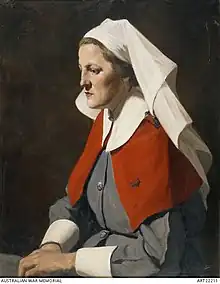Margaret Irene Anderson | |
|---|---|
 | |
| Born | 11 December 1915 |
| Died | 16 July 1995 (aged 79) |
| Nationality | Australian |
| Occupation | nurse |
| Employer | Australian Army Nursing Service |
| Known for | heroism |
| Spouse | Allen Ronald O’Bryan |
Margaret Irene Anderson GM (11 December 1915 – 16 July 1995) was an Australian Army nurse. Anderson was awarded a George Medal for her heroism while caring for the wounded at sea after the invasion of Singapore in 1942. Lieutenant Anderson continued to serve on hospital ships until 1945.
Life
Anderson was born in 1915 in the Melbourne suburb of Malvern. Her parents were Jessie Blanchrie (born Urquhart) and Charles Anderson and they had both been born in Australia. Her father was employed as a driver. She qualified as a nurse in 1940 at the Austin Hospital in Melbourne's suburb of Heidelberg and in the same year she became a staff nurse in the Australian Army Nursing Service.[1]
In 1941 she was aboard the SS Zealandia which had left Melbourne on 2 November and then arrived in Singapore on 20 November. The ship was escorted by HMAS Sydney which was on one of its last trips. She and Vera Torey, who she had trained with in Heidelberg, were assigned to the 13th General Hospital which was itself moving from Singapore to Tampoi. Their eight-storey building was inappropriate, but during that November, 100 tons of equipment was moved to Tampoi. She and Torey would have been on night duty on 2 December 1941 when they heard what was assumed to be their air force practising night bombing. They were not aware that Japan had joined the war, but very soon the casualties arrived. By 16 January casualties arrived around the clock and all the nurses worked long hours. They heard on the radio that Japanese forces planned to use their building on 26 January.[2]
On 8 February the Japanese invasion of Singapore began. In the harbour Empire Star had loaded equipment and stores and over 2,000 people.[3] These people were British and Australian military and 133 army nurses including Anderson. The nurses were members of the Australian Army Nursing Service from two Australian Army Medical Corps hospitals.[3] The ship had set sail with would-be passengers held back at gun point. In fact 139 Australian servicemen were later arrested for travelling without authorisation. Some of the passengers were loaded in jewellery as they all left with what they could.[4]

On 12 February, six Japanese dive-bombers attacked the ship and its convoy. Anti-aircraft fire shot down one aircraft and damaged another, which broke off from the attack. The Empire Star was set afire in three places and several people on board were killed. Anderson was among the Australian nurses who tended the wounded below decks. When they thought the attack was over they brought their patients into the fresh air. As aircraft again machine-gunned the ship, Anderson and Veronica ("Vera") Torney, threw themselves upon wounded soldiers to protect them from further injury[4] while the ship took "violent evasive action".[5]
In September 1942 numerous members of the ship's company were decorated for their part in the operation.[6][7] Margaret Anderson was awarded the George Medal[8] and "Vera" Torney was awarded the Military MBE.[9] Anderson then returned to nursing in Australia where she had been promoted to be a sister. In January 1943 she joined MS Wanganella which had become a hospital ship in 1941. During 1943 she, like other Australian nurses, was given a military rank and she became Lieutenant Anderson. She was with the Wanganella as it travelled to Italy, New Guinea and hospitals in Australia until August 1945.[1]
After the war she worked as a clerk in Malvern and married Allen Ronald O'Bryan in 1956. She died on 16 July 1995 at Frankston.[1]
Awards
.jpg.webp)
Anderson was given several awards in addition to the George Medal including the Pacific Star and the Italy Star.[8]
References
- 1 2 3 Rae, Ruth, "Margaret Irene Anderson (1915–1995)", Australian Dictionary of Biography, Canberra: National Centre of Biography, Australian National University, retrieved 28 December 2023
- ↑ Matthews, Tony (6 January 2021). Quiet Courage: Forgotten Heroes of World War Two. Simon and Schuster. ISBN 978-1-922387-68-4.
- 1 2 Taffrail 1973, p. 61.
- 1 2 "Remembrance 2022 by Shrine of Remembrance – Issuu". issuu.com. 1 November 2022. pp. 56–59. Retrieved 29 December 2023.
- ↑ Taffrail 1973, p. 62.
- ↑ "Central Chancery of the Orders of Knighthood". London Gazette. 11 September 1942. p. 4017. Retrieved 17 August 2014.
- ↑ Taffrail 1973, p. 64.
- 1 2 "Lieutenant Margaret Irene Anderson". www.awm.gov.au. Retrieved 29 December 2023.
- ↑ "The Australian Women's Register".
Sources
- "Taffrail" (Henry Taprell Dorling) (1973). Blue Star Line at War, 1939–45. London: W. Foulsham & Co. pp. 61–64, 109–113. ISBN 0-572-00849-X.